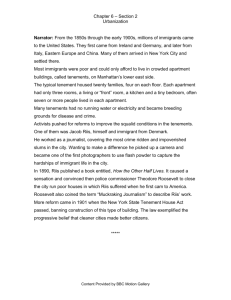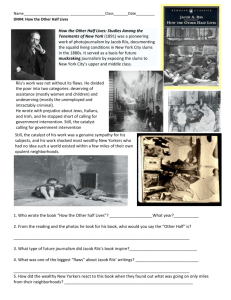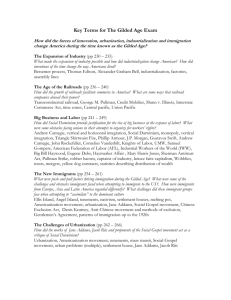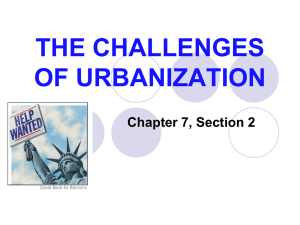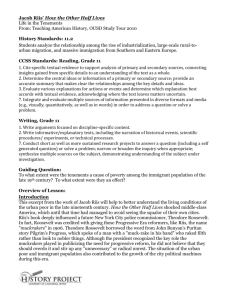Jacob Riis Photography - Community Unit School District 308
advertisement
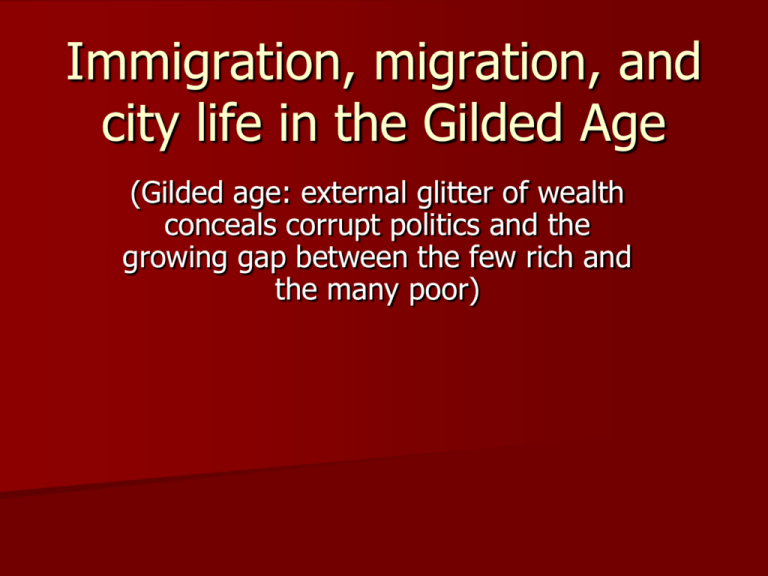
Immigration, migration, and city life in the Gilded Age (Gilded age: external glitter of wealth conceals corrupt politics and the growing gap between the few rich and the many poor) Class and Industry The shift from an agrarian to an industrial economy brought new patterns of production and created a new class structure. – Factory assembly lines replaced apprentice workshops. – Machines replaced skilled craftsmen. – A new working class of semi-skilled wage laborers operated the machinery. By 1900, the industrial workforce comprised one third of the population Class and Industry The upper-class entrepreneurs who controlled American industries and the middle-class managers who supported them formed "one half" of Gilded Age society. – These businessmen promoted the doctrine of free labor as the symbol of American democracy. – Using themselves as examples, they argued that Americans could achieve success through hard work. – They built mansions for their families and donated funds for parks and public architecture to display their newfound wealth and social power. “The Other Half” "The other half" of Gilded Age society consisted of working-class families. – One out of every three laborers was an immigrant. Lured by the promises of freedom and opportunity motivated by the desire to escape oppressive living and working conditions at home many immigrants sold their possessions and moved to America. often, however, they found themselves in similar situations in this country. What is an American? Melting Pot Versus Fruit Salad “America Is the Great Melting Pot” – What does this actually mean? How about a theory using “Fruit Salad” instead? – Healthier? – Socially correct? Port of Entry Ellis Island / Angel Island – Europeans treated a little better than Asians entering in California – From 1892 to 1954, over twelve million immigrants entered the U.S. at Ellis Island – Around 3% were sent back to their countries of Origin due to being found “undesirable” Main Sources of Immigration 1861-1890 From 1861 to 1890, the country that had the most immigrants come to the United States was….? From 1861 to 1870, the country that had the least amount of immigrants come to the United States was….? Once in America they became “the other half” About 40 percent of working-class citizens lived below the poverty line of $500 per year. They faced long hours, – – – – – low pay, random wage cuts, periods of high unemployment, danger to life and limb on the job, lack of insurance, and lack of worker's compensation. The overcrowded tenements in which they lived often had inadequate sewage, heat, water, and electricity. Horatio Alger writes over 100 Social Darwinism books Based on Darwin’s Theory Evolution about theof“Self-Made Man” – “Natural Selection” •If –men like Andrew Survival of the fittest Carnegie can Government so can you!should not interfere with business – God did not interfere with a dying species Weakabusinesses be allowed to die •Is –this myth orshould a reality? – Poor People deserve to be poor! do it Social Darwinism at work The native customs of working-class immigrants seemed foreign to middleclass and upper-class citizens. Their neighborhoods seemed mysterious and dangerous. The media reinforced the stereotype of working-class citizens as "other," portraying them as immoral, ignorant, or unable to help themselves. Reform Efforts? Gilded Age reformers appealed to the consciences and fears of these citizens, encouraging them to serve as guardians of the poor and protect themselves against crime. Jacob Riis Lewis Hine Jacob Riis— How the Other Half Lives documented the living and working conditions of the poor Riis argued for better housing, adequate lighting and sanitation construction of city parks and playgrounds. He portrayed middle-class and upper-class citizens as benefactors and encouraged them to take an active role in defining and shaping their communities. Riis believed that charitable citizens would help the poor when they saw for themselves how "the other half" lived Photography of Jacob Riis http://xroads.virginia.edu/~MA01/Davis/photography/slideshows/slideshows.html According to historian Robert Bremner: "The reformers' problem was to rouse the public from its lethargy, make consciences uneasy, and stir genial good will into enthusiasm for social betterment. Their first step was to lay bare the responsibility of the community for needless suffering." Nurture, Not Nature Critics of charities argued that poverty was the result of individual or moral weakness; poor could not be helped through charitable donations. Gilded Age reformers like Riis believed that poverty was the result of environmental conditions; thus, reform efforts could help the poor. Riis’ ideas on Charity "The reason charity has been discredited is because it has worked with the broken fragments, the drunken and the shiftless, helping as it could, mourning that such things must be, but never asking the reason why or knowing anything of the honest, thrifty poor who live lives of heroism such as we cannot live." Riis’ ideas on Charity Riis believed that moral citizens, regardless of their economic status, should be given a chance to improve their lives. Like Riis himself, given that chance, many could rise out of poverty and into the ranks of the middle class Riis’ ideas on Charity He believed that private wealth could help transform the slums into better places to live. "I am a believer in organized, systematic charity upon the evidence of my senses," Neighborhoods Riis's photographs had a certain shock value. He looked for images that would have a strong effect on his viewers—dirty children on the streets, men living in dumps and cellars. Mothers and Children Riis's photographs challenged Victorian notions of mothers and children. One of his photographs shows a mother with her naked children standing on a rooftop. In others, children play out on the streets unattended. These photographs contrasted sharply with images of children in late-nineteenth-century America. Dwellings Riis's photographs also challenged Victorian notions of the home. In one photograph, a tenement family makes cigars at the table. In another, a man sits down to a solitary meal in a coal cellar. De-Emphasizing the Individual He often de-emphasized the individual in favor of the total setting. Accordingly, he photographed many of his subjects at a distance to show them in their squalid surroundings. Bandit’s Roost “Most dangerous alley in New York City”
